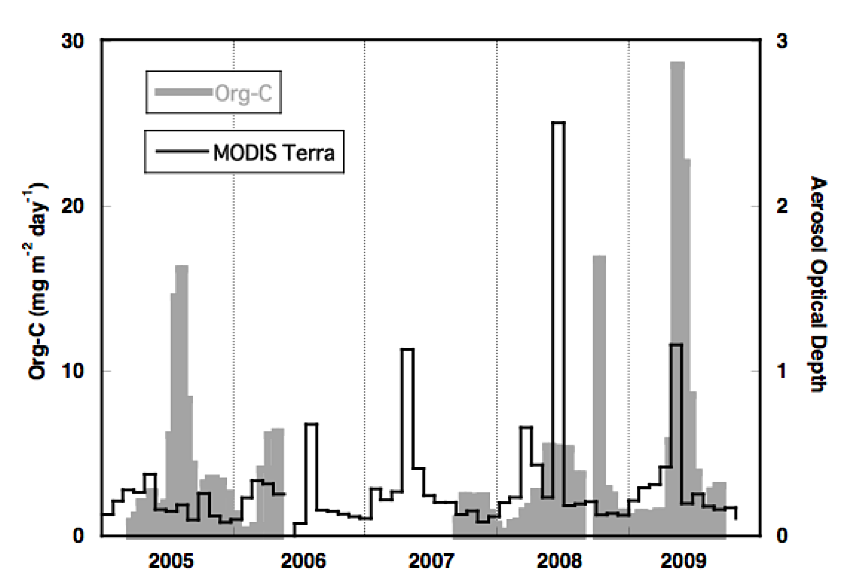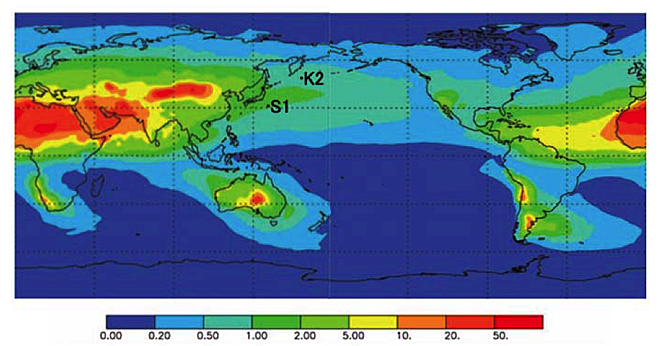2. Background
2.1 Marine biological pump
The global ocean reservoir of CO2 is estimated to be 60 times greater than that in the earth atmosphere. The ocean absorbs about 30% of anthropogenic CO2 and, thus, it can be said that the ocean controls the amount of atmospheric CO2. One mechanism for the uptake of oceanic CO2 is the biological pump, in which CO2 is assimilated by phytoplankton during photosynthesis, cycled within the food web, and transported to the ocean interior in the form of settling particles of detrital material (marine snow). Globally, the marine biological pump is estimated to transport 11 GT of carbon annually to the ocean interior (IPCC AR4, 2007). Without the constant drawdown of near-surface oceanic CO2 by the biological pump, it is estimated that the atmospheric concentration prior to the industrial revolution (280 ppm pCO2(air)) would have been as high as 400 ppm (Sarmiento and Toggweiler, Nature 308, 1984). It is also reported that high primary production in the North Pacific gyre, dominated by large diatoms, results in a net export of near-surface carbon and, therefore, a net uptake of atmospheric CO2 (Honda, J. Oceanogr. 59, 2003). However, recent observations have indicated a weakening of the Western Pacific biological pump due to a decrease in the concentration of diatoms (Watanabe et al., J. Oceanogr., 65, 2007; Ono et al., Geophys. Res. Lett., 22, 2002).
2.2 Impact of atmospheric dust deposition
It is well documented that aeolian dust deposition on the global ocean is a primary source of anthropogenic reactive nitrogen, often resulting in elevated primary production (e.g. Duce et al., WMO Bulletin 58 (1), 2009). For example, primary production in the Japan Sea has been reported to increase in association with Asian dust (Kosa) events (Jo et al., Geophys. Res. Lett. 34, 2007). Likewise, temporal variability in the flux of sinking particles in the western North Pacific tends to correlate with the occurrence of sand storms observed in China (Yuan and Zhang, Geophys. Res. Lett. 33, 2006). It is suspected that the former is attributed to aeolian input of nutrients such as phosphorus, nitrate, and iron and the latter is attributed to the atmospheric supply of natural “ballast” that increases the density of particle aggregates (marine snow). These observed impacts of atmospheric dust deposition on the biological pump forms the basis of a hypothesis: the drawdown of pCO2(air) is in part due to enhanced marine primary production and vertical transport of particulate carbon away from surface waters fueled by the deposition of atmospheric dust and associated nutrients. This could, for example, explain the drawdown of pCO2(air) during the last glacial maximum (Martin, Paleoceanogr. 5, 1990; Ittekkot, EOS 72,1991). Recent iron fertilization experiments in high nutrient, low chlorophyll ocean areas have revealed that iron input increases primary production (e.g., Tsuda et al., Science 300, 2003). Additionally, there is evidence that volcanic dust deposition increases ocean primary production (Uematsu et al., GRL 31, 2004). However, fundamental issues remain, such as the time scale required for phytoplankton to utilize dust-borne nutrients and the associated rate of particle removal from the near-surface ocean.

Figure 2. Temporal variability of organic carbon flux at 5000m and aerosol optical depth derived from Terra/MODIS data (Honda and Kanaya, unpublished data). Are these two factors correlated and what causes inter-annual variability?
2.3 Toward understanding biological pump responses to atmospheric aerosol particle deposition
The deposition flux of atmospheric dust on the western North Pacific Ocean, originating from Asian desert areas and loess plateau, is estimated to be relatively large (Fig. 3; Jickells et al., 2005). Although many researchers have reported on Asian soil dust transport, the affect of dust deposition on the marine biological pump is not well understood. Complicating factors include changes in dust transport flux and deposition areas in response to changes in climate, meteorological regimes, and land-use. In addition to soil dust, the influence of industrial sources of atmospheric aerosols, which are increasing in East Asia (Kanaya et al., 2010), on the marine biological pump has not been well studied.

(modified from Jickells et al., 2005)